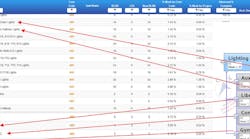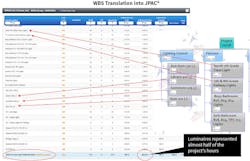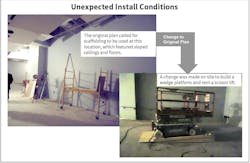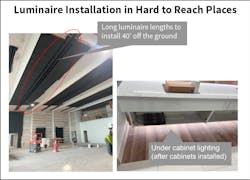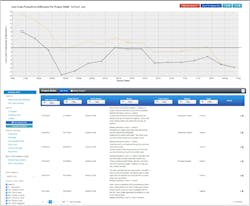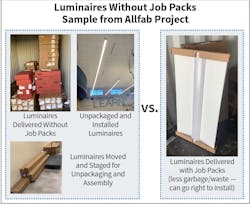Planning Job-Site Lighting Installations
Of all the things that electricians produce, light is the most visible (no pun intended) to the customer and consumer. While they also bring “the power,” those outlets, internet connections, and safety systems don’t deliver the same aura to space as luminaires and controls. However, bringing that light can be one of the most painful parts of a job for the electrician.
Luminaires and devices are installed in the second half of a project and can bring a myriad of productivity-killing issues. The supply chain also contributes — from picky customers to engineering changes or mistakes — in addition to the delays in getting the luminaires made and moved without damage.
Based on our JPAC® database of thousands of projects, luminaires contribute between 10% and 20% to a project’s hours, depending on the nature of the work. It is one of the most commonly tracked labor codes, but the largest code by hours when compared to conduit and wire. Therefore, the weight of luminaires alone does not drive the project outcome; however, the issues can erode the gains of a great “first half” (e.g., underground, rough-in, distribution, etc.) without a solid plan. This article will share real examples of luminaire headaches. It will also share solutions for making your plan for luminaires as illuminating as the light they produce.
Allfab Group, building on decades of highly productive projects led by its president, Kevin Lytle, attributes its success with luminaires on projects to three things:
- Supplier and manufacturer coordination and planning
- Off-site receiving, delivery, and storage
- Just-in-time delivery and placement on the job site
These all sound like no-brainers; however, they take effort and focus in planning up front and throughout the project.
Planning for luminaires
The process of planning luminaires is a long one with a lot of unknowns along the way. Lytle starts by looking at the submittals to get an idea of what luminaires may need approval from the customer. With experience with certain luminaire types or lighting control systems, the work and effort can be planned much more easily. The work breakdown structure (WBS) process is perfect for getting the “knowns” on paper, and then leaving some space for follow-up approved submittal review. See Fig. 1 for a sample of a WBS for luminaire work that can be used for planning any luminaire type. Figure 2 shows a sample of how Lytle’s luminaire WBS translates into JPAC® for tracking. The level of breakdown reflects the thought (and research) behind each luminaire type and installation area, allowing better planning for those luminaires and observing their percentage completion more accurately for measuring productivity.
Other considerations during your WBS for luminaire work include:
- How will the luminaires be delivered?
- What will the work conditions be for moving and installing the luminaires?
- What hardware will come with the luminaires? Will/can any of that be pre-assembled?
- What are the lighting controls (e.g., wired, wireless, Bluetooth, etc.)?
The key for luminaires, and any work that will occur “later in the job,” is to continue to revisit the WBS often. Revisiting the work (and potentially the effort) as more becomes known about the luminaires and their installation, is crucial to the process. This is also why it’s critical to release luminaires as soon as they are approved so that you can lock in the plan, including coordinating quantities and staging with suppliers, and avoid supply chain delays. Changes to that plan can then be tracked accordingly. Luminaires should also be incorporated into a project schedule, linking the impact of submittals, release, and up front decision delays to downstream installation impacts that may be months away.
Tracking the plan and measuring deviations
Once the luminaires are ordered, they sometimes get forgotten until it is time to release them to the job site. The conditions of their installation, packaging, and kitting can all have changed from what you expected in the initial WBS. Missing parts, damages, and plain “wrong luminaires” all bring wasted effort and time late in the game. Figure 3 and Fig. 4 show samples of work required in an area that was not part of the original plan. These differences will show up immediately with the usage of ASTM E2691.
Figures 5 and 6 show data from one of Allfab’s projects. The project was a remodel, which brought its own challenges with difficult installation conditions. Savings were realized on this project by the use of Bluetooth-based lighting controls. Although this was a newer technology (requiring some studying/learning up front), Lytle found it simpler than running low-voltage cables and worrying about switch legs. According to Lytle, this type of system is also easier to troubleshoot because you don’t need to trace down damaged or faulty wiring.
Lytle also emphasizes how much “trash” is associated with luminaire packaging. For example, with 16-ft to 20-ft luminaires, moving and cleaning up this trash drove his luminaire cost code into the ditch (see Fig. 5). Per the checklist below, this can all be avoided based on how luminaires are ordered.
Checklist to avoid risks in fixtures & lighting controls
-
Use WBS up front and revisit every 25%.
-
Review submittals and research/follow up with distributor and/or manufacturer for:
- Detailed installation instructions (special installation hardware, hangers, needed, lighting control technology).
- See if lighting internal controls can be installed at the factory.
- Luminaire packaging and shipping expectations.
- Plan for non-installation work (what, who where, when these thing should happen):
- Research, understanding how the luminaire/controls work.
- Receiving (including inspection and damage).
- Site delivery details/plan (focus on reduced packaging options and breakdown quantities for less “bulk movement”).
- Assembly.
- Testing and troubleshooting.
- Cleaning and labeling.
- Supply chain impacts:
- Review and communicate the schedule (yours and the distributor/manufacturers), make decision-making delays visible early, and use the schedule to set optimal delivery times.
- Request job packs (kitting, packaging breakdown of luminaires when possible to avoid excessive trash, as seen in Fig. 7).
- Tracking — separate labor code, detailed reason code.
About the Author
Dr. Heather Moore
Vice President of Operations
Kevin Lytle
Kevin Lytle is president of Allfab Group in Omaha, Neb. He can be reached at [email protected].
